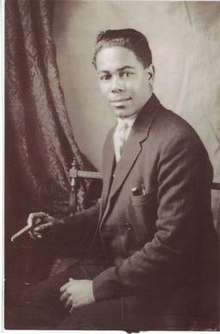Denver D. Ferguson
Denver Darious Ferguson (February 19, 1895 – May 11, 1957) was an American businessman and nightclub owner in Indianapolis, who had a leading role in establishing the "Chitlin' Circuit" of entertainment venues for black entertainers and audiences in the 1930s and 1940s.[1] Earlier in his career he established a newspaper The Edmonson County Star, in his home town of Brownsville, Kentucky, before moving to Indianapolis where he had a printing company. His younger brother Sea Ferguson helped in the print shop and with his other business ventures. After leaving the publishing business, Denver Ferguson became successful in illegal gambling and invested in property as well as a talent management and promotion business. Musician and record producer Sax Kari described him as "the man who invented the chitlin’ circuit".

Early life and family
Denver Ferguson was born in Brownsville, Kentucky, in 1895, the eldest son of Mattie (née Whitney) and Samuel Henry Ferguson. His younger brother Sea Harious Ferguson (December 22, 1899 – March 10, 1974), who became a property developer and working partner of his elder brother, was also born in Brownsville.[2]
Career
When in his teens, Denver acquired a printing press, and in about 1914 founded the Edmonson County Star newspaper in Brownsville. He was drafted in 1917, and after his discharge in 1919 moved north to Indianapolis. The following year he established the Ferguson Printing Company, and soon set up his premises on Indiana Avenue. Many of his clients organised a street lottery, the "numbers game" or "policy game", and Ferguson designed and printed tickets resembling a baseball scorecard. When his success in running the illegal racket started to draw unwelcome official attention to himself, he recruited his brother Sea to be the public face of the operation. Sea Ferguson opened a real estate brokerage in the city, and the two brothers became renowned locally for their generosity in extending loans and giving to charitable causes in the local black community.[3][4]
In 1931, Sea Ferguson opened the Cotton Club nightclub in Indianapolis, and the following year Denver Ferguson opened the Trianon Ballroom, featuring Walter Barnes as his first star attraction. Barnes was experienced in touring with his band around the South, and wrote a regular column in The Chicago Defender until his death in the Rhythm Club fire in Natchez, Mississippi in 1940. The Theatre Owners Booking Association (TOBA) had collapsed in late 1930, and the Ferguson brothers drew on Barnes and his contacts to bring top black entertainers to Indianapolis.[5] In 1938, Denver Ferguson opened the Sunset Terrace ballroom in Indianapolis, featuring Tiny Bradshaw, Earl Hines, Duke Ellington and Ella Fitzgerald in its early months.[6] Largely as a result of the Ferguson brothers' initiatives, commercial activity thrived on Indiana Avenue in the late 1930s. In 1939 a full page announcement in the Indianapolis Recorder with well wishes from businesses announced his opening of the New Sunset Terrace venue in Indianapolis.[7] However, in 1940 a clampdown by the authorities under Mayor Reginald H. Sullivan led to their businesses' licenses being revoked.[2]
By the late 1930s, both Denver and Sea Ferguson were seen as among the wealthiest residents of Indianapolis.[3] In 1941, they opened Ferguson Brothers, a booking agency, which grew rapidly and became the most powerful black-owned talent agency in the country.[2] They helped various orchestras, bands, and vaudeville shows book gigs, including Jay McShann, King Kolax, Tiny Bradshaw, Roosevelt Sykes, Claude Trenier, the Bama State Collegians, Carolina Cotton Pickers, Snookum Russell, Milton Larkin, Clarence Love, Gene Pope, and the International Sweethearts of Rhythm, and organised tours around the South playing to black audiences.[8][9]
In 1944, Denver Ferguson reopened Le Jazz Hott Spot in Chicago as part of his syndicate.[10] He was a mentor to Sax Kari,[8][2] who worked for him and who assisted writer Preston Lauterbach in preparing his 2011 book The Chitlin' Circuit and the Road to Rock 'n' Roll, documenting the Ferguson brothers' work and influence.[11]
Personal life
Denver Ferguson married a German woman, Lilo Rantlach, with whom he had been in correspondence.[12] After a brief marriage, they divorced. In 1954, Ferguson faced a lawsuit after an automobile accident.[13]
Death
Ferguson died in 1957 in Indianapolis and is buried at Page-Ferguson Cemetery in Brownsville, Kentucky.[14]
References
- "The Chitlin' Circuit and the Road to Rock 'n' Roll".
- "Denver D. Ferguson". Preston Lauterbach.
- "Ferguson, Denver and Sea (brothers) ", University of Kentucky Libraries Notable Kentucky African Americans Database. Retrieved 4 November 2015
- Lauterbach, Preston (2011). The Chitlin' Circuit and the Road to Rock'n'Roll. New York: W. W. Norton. p. 17-27. ISBN 978-0-393-34294-9.
- Lauterbach, pp.31-42
- Lauterbach, pp.59-60
- "Indianapolis Recorder 24 December 1938 — Hoosier State Chronicles: Indiana's Digital Historic Newspaper Program". newspapers.library.in.gov.
- Lauterbach, Preston (July 18, 2011). The Chitlin' Circuit: And the Road to Rock 'n' Roll: And the Road to Rock 'n' Roll. W. W. Norton & Company. ISBN 9780393082258 – via Internet Archive.
denver d ferguson.
- John Morthland, "The Chitlin’ Circuit: Celebrating a Secret History of American Music", WonderingSound.com, 1 November 2011. Retrieved 25 November 2019
- Inc, Nielsen Business Media (March 18, 1944). "Billboard". Nielsen Business Media, Inc. – via Google Books.
- Eagle, Bob L.; LeBlanc, Eric S. (May 1, 2013). Blues: A Regional Experience. ABC-CLIO. ISBN 9780313344244 – via Google Books.
- Company, Johnson Publishing (June 17, 1954). "Jet". Johnson Publishing Company – via Google Books.
- Company, Johnson Publishing (May 20, 1954). "Jet". Johnson Publishing Company.
- "Denver Ferguson". Find A Grave. Retrieved 19 November 2019.
External links
- "Denver Ferguson" profile from Preston Lauterbach